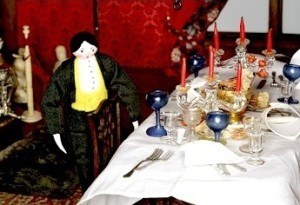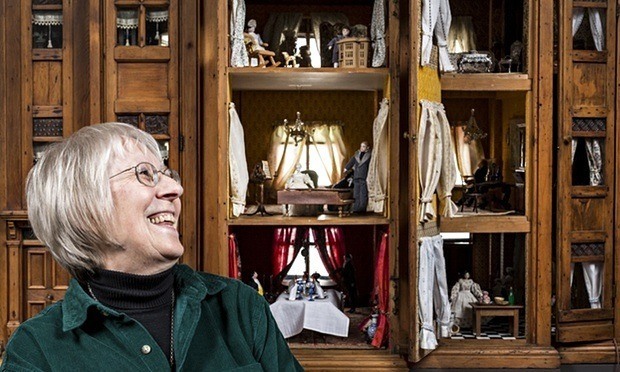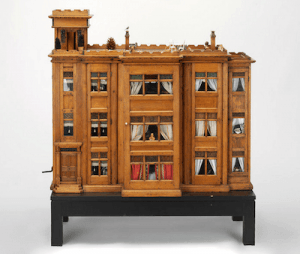Betty Pinney’s House – An Empty Shell
The miniature now known as Betty Pinney’s House – Bettiscombe was found by a friend who ran an antique shop and sold it to Betty Pinney for £5. The house was made in about 1870, of Gothic design, with more than 10 rooms, a roof garden and a lift which can be operated by turning the handle … gently.
Betty Pinney was born in 1907. She studied art and later on designed wallpapers and textiles for the Edinburgh Weavers and then for Sandersons. She designed book covers, posters and also illustrated books. She spent the next 20 years restoring and furnishing the dolls house.

Betty Pinney’s Bedroom, 1870 (1900-10 interior), now on exhibit at the Victoria & Albert Museum, London.
Childhood – A Recreated Memory
“The house reflects my mother,” her daughter Susanna told the Manchester Guardian. “She was recreating her childhood in miniature, not as it really was, but an idealized version, more exciting than her very strict Edwardian childhood.”
The house is a portrait of life in a wealthy household from the late 19th to early 20th centuries. combining this with a family who had worked abroad for the Empire which gave her greater freedom with the furnishings. She spent the next 20 years restoring and furnishing it.

Betty Pinney’s Dining Room,, 1870 (1900-10 interior), now on exhibit at the Victoria & Albert Museum, London, which provided the photograph.
An Edwardian Upbringing
Betty grew up in Oxford, where her father was a professor at Christchurch college, and then in a Georgian manor house in the village of Bettiscombe, Dorset, where he became a rector. She, like the inhabitants of her doll’s house, was accustomed to having staff. “She said butlers always had paunches and footmen were chosen for their elegant calves, so she had someone carve the dolls appropriately.”
New dolls were always given a role. “As well as being fastidious about scale, she also objected to inactive dolls. She wanted all hers to be doing things. She made tiny dusters for the maids when she plucked a pheasant.”
Everything Just So
Betty, an artist and illustrator, collected and painstakingly made hundreds of miniature decorations, fixtures and fittings for the doll’s house. She commissioned a carpenter to make precise copies of the family’s own Georgian dining table and chairs and Steinway grand piano.
“There are so many hours of work – it had to be perfect, Susanna Pinney said. “She was totally absorbed by it. The house is just as she wanted it, and when I see it I am reminded how she always lived her life as an artist. I always loved watching her work.”
Physical Description
Rectangular shaped dolls’ house of unpainted wood with a flat castellated roof supporting two chimneys. There is a tower adjoining one short end which extends beyond the roof and contains a lift which is operated by turning a metal crank handle at the base. The house is accessible at all sides through six hinged full-length doors and one small hinged door. There are also two removable panels in the center of each long side. The house has three floors: Ground floor with kitchen (with back door), dining room and hallway (with a front door and steps); First floor with spare bedroom, drawing room and landing; Second floor with bedroom, chapel, nursery, and landing. There is a roof garden which is accessible via the lift in the tower. The rooms are wallpapered and carpeted throughout as well as being fully furnished. All the windows are glazed; with curtains or blinds.
Not long before Betty died in 1982, Susanna bought her two male dolls. Her mother was too ill with cancer to dress them. “They are the only two dolls in their shop clothes. She always made exquisite outfits for them.”
See It in D.C.
Watch Illean Ottini’s wonderful video, showing all of the rooms of Betty Pinney’s dolls house
Many thanks to the Manchester Guardian and photographer David Levene, sources for this post.
Susan Downing, with Patrick Owens
_________________________________________________________________________
I invite you to visit my Etsy Shop where I offer many accessories and pieces of furniture in 1:12 scale.







